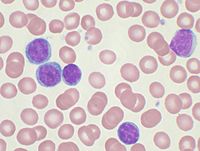
Photo from wikipedia
Hodgkin lymphoma (HL) accounts for approximately 30% of all malignant lymphomas in Western countries, and approximately 5–10% in Japan. It has a bimodal incidence pattern across age groups with one… Click to show full abstract
Hodgkin lymphoma (HL) accounts for approximately 30% of all malignant lymphomas in Western countries, and approximately 5–10% in Japan. It has a bimodal incidence pattern across age groups with one peak in young adults (20s) and the other in middle-aged adults (50–60 years old). Many patients are initially asymptomatic or have painless superficial lymphadenopathy. Approximately 75% of cases are detected from cervical and supraclavicular lymphadenopathy. A mediastinal mass is detected in approximately 60% of patients with nodular sclerosis HL. Hematologic findings include leukocytosis, lymphopenia, eosinophilia, anemia, elevated alkaline phosphatase, elevated erythrocyte sedimentation rate, elevated CRP, and reduced cell-mediated immunity. Histopathologically, HL is a lymphoma characterized by proliferation of tumor cells such as Hodgkin/Reed–Sternberg (HRS) cells and lymphocyte predominant (LP) cells (“popcorn” cells). In 2017 WHO Classification, HL is classified into two subtypes: nodular lymphocyte-predominant Hodgkin lymphoma (NLPHL) and classical Hodgkin lymphoma (CHL) [1, 2]. HRS cells are characteristic of CHL, and LP cells of NLPHL. CHL is further classified into four additional subtypes: nodular sclerosis, lymphocyte-rich classical, mixed cellularity, and lymphocyte-depleted Hodgkin lymphomas. HL is classified into stages I through IV using the Ann Arbor staging system.
Journal Title: International Journal of Hematology
Year Published: 2019
Link to full text (if available)
Share on Social Media: Sign Up to like & get
recommendations!